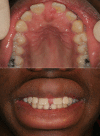Multiple endocrine neoplasia-2B presenting with orthodontic relapse
- PMID: 20050756
- PMCID: PMC8985720
- DOI: 10.2319/042009-222.1
Multiple endocrine neoplasia-2B presenting with orthodontic relapse
Abstract
The multiple endocrine neoplasia (MEN) syndromes are a relatively uncommon group of genetic disorders characterized by the development of tumors in various endocrine organs. MEN type 2B is of particular interest to the dental profession because of its oral manifestations, which are often some of the earliest clinically detectable signs of the disorder. Early identification of this syndrome is critical because affected patients often develop a characteristic malignancy, medullary carcinoma of the thyroid, at a very early age. We describe a 17-year-old male whose initial diagnosis of MEN-2B was triggered by his orthodontist's request for an oral and maxillofacial pathology consultation to evaluate the patient's oral abnormalities.
Figures







Similar articles
-
A case of multiple endocrine neoplasia type 2B.Jpn J Clin Oncol. 1997 Aug;27(4):268-73. doi: 10.1093/jjco/27.4.268. Jpn J Clin Oncol. 1997. PMID: 9379517
-
Multiple endocrine neoplasia type 2B.Int J Urol. 2001 Jul;8(7):398-400. doi: 10.1046/j.1442-2042.2001.00320.x. Int J Urol. 2001. PMID: 11442663
-
Choroidal metastasis from medullary thyroid carcinoma in multiple endocrine neoplasia.Am J Ophthalmol. 2002 Oct;134(4):607-9. doi: 10.1016/s0002-9394(02)01634-3. Am J Ophthalmol. 2002. PMID: 12383823
-
Multiple idiopathic mucosal neuromas: a minor form of multiple endocrine neoplasia type 2B or a new entity?J Am Acad Dermatol. 1997 Aug;37(2 Pt 2):349-52. J Am Acad Dermatol. 1997. PMID: 9270546 Review.
-
Multiple endocrine neoplasia type 2B (mucosal neuroma syndrome, Wagenmann-Froboese syndrome).J Med Genet. 1996 Sep;33(9):779-82. doi: 10.1136/jmg.33.9.779. J Med Genet. 1996. PMID: 8880581 Free PMC article. Review.
Cited by
-
Demographic, Clinical and Histopathological Features of Oral Neural Neoplasms: A Retrospective Study.Head Neck Pathol. 2019 Jun;13(2):208-214. doi: 10.1007/s12105-018-0943-1. Epub 2018 Jun 21. Head Neck Pathol. 2019. PMID: 29931661 Free PMC article.
-
Common conditions associated with mandibular canal widening: A literature review.Imaging Sci Dent. 2019 Jun;49(2):87-95. doi: 10.5624/isd.2019.49.2.87. Epub 2019 Jun 24. Imaging Sci Dent. 2019. PMID: 31281785 Free PMC article. Review.
References
-
- Kronenberg H. M. Polyglandular disorders. In: Goldman L, Ausiello D, editors. Cecil Medicine. Philadelphia, Pa: Saunders Elsevier; 2008. 23rd ed. MD Consult Web site. Available at http://www.mdconsult.com/das/book/body/113528956-3/0/1492/0.html Accessed February 2, 2008.
-
- Maitra A, Abbas A. K. The endocrine system. In: Kumar V, Abbas A. K, Fausto N, editors. Robbins and Cotran Pathologic Basis of Disease. Philadelphia, Pa: Saunders Elsevier; 2005. 7th ed. MD Consult Web site. Available at http://www.mdconsult.com/das/book/body/113528956-5/0/1249/0.html Accessed February 2, 2008.
-
- Haveman C. W, Sloan T. B, Long R. T. Multiple endocrine neoplasia syndrome, type III: review and case report. Spec Care Dentist. 1995;15:102–106. - PubMed
-
- Kahn M. A, Cote G. J, Gagel R. F. RET protooncogene mutational analysis in multiple endocrine neoplasia syndrome type 2B: case report and review of the literature. Oral Surg Oral Med Oral Pathol Oral Radiol Endod. 1996;82:288–294. - PubMed
-
- Lips C. J. Clinical manifestations and diagnosis of multiple endocrine neoplasia type 2. In: Basow D. S, editor. UpToDate. Waltham, Mass: UpToDate; 2008.
Publication types
MeSH terms
LinkOut - more resources
Full Text Sources

